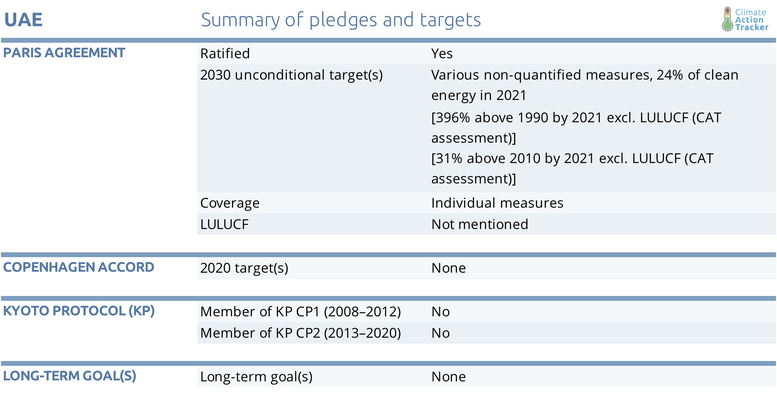Pledges And Targets
Summary Table

Paris Agreement targets
On 22 October 2015, the United Arab Emirates submitted its INDC, pledging it will aim at diversifying its economy through plans and actions that will yield co-benefits in mitigation and adaptation to climate change, including a target of increasing “clean energy” (defined as renewable energy and nuclear energy) from 0.2% in 2014 to 24% of the “total energy mix” by 2021. Although this is not clearly specified in the NDC, we assume that this target refers to the electricity mix based on a series of supporting documentation (Ministry of Energy, 2015c; The National, 2015; UAE Government, 2018):
On 21 September 2016, the UAE ratified the Paris Agreement, turning their INDC into the NDC.
Beside the clean energy target, measures targeting the energy, buildings and transport sector are listed in the document. None of these targets have numbers in terms of emissions reductions attached to them.
The measures mentioned are the following:
- Promote the reduction of gas flaring in its oil and gas industry and make use of carbon capture, usage and storage (planned).
- Increase the electricity tariff to leverage the potential of demand side management (planned).
- Efficiency standards in the building sector in Abu Dhabi (established in 2011) and in Dubai from 2014 (established in 2014).
- Efficiency standards for residential appliances to phase out inefficient products from the market (already in place).
- Deregulation of fossil fuel prices (established in August 2015).
- Investments in light rail and metro system in Dubai (already in place).
- Rail network connecting all seven emirates (planned).
As the list above shows, most of these measures can already be considered implemented policies. Therefore, we expect limited additional emission reductions. The share of 24% of clean energy leads to emission levels being slightly lower compared to our current policy projections in 2021 (~220-240 MtCO2e), at 234 MtCO2e/a in 2021 which translates into about 21% above 2010 levels.
The National Climate Change Plan says the UAE has increased its clean energy target for 2021 from 24% to 27% (MOCCAE, 2017) This update is not reflected in the official documents submitted to the UNFCCC, thus we rely on the 24% target. If a 27% target is implemented, emissions would be slightly lower in 2021, at 231 MtCO2e/a or 20% above 2010 levels.
Further analysis
Latest publications
Stay informed
Subscribe to our newsletter




